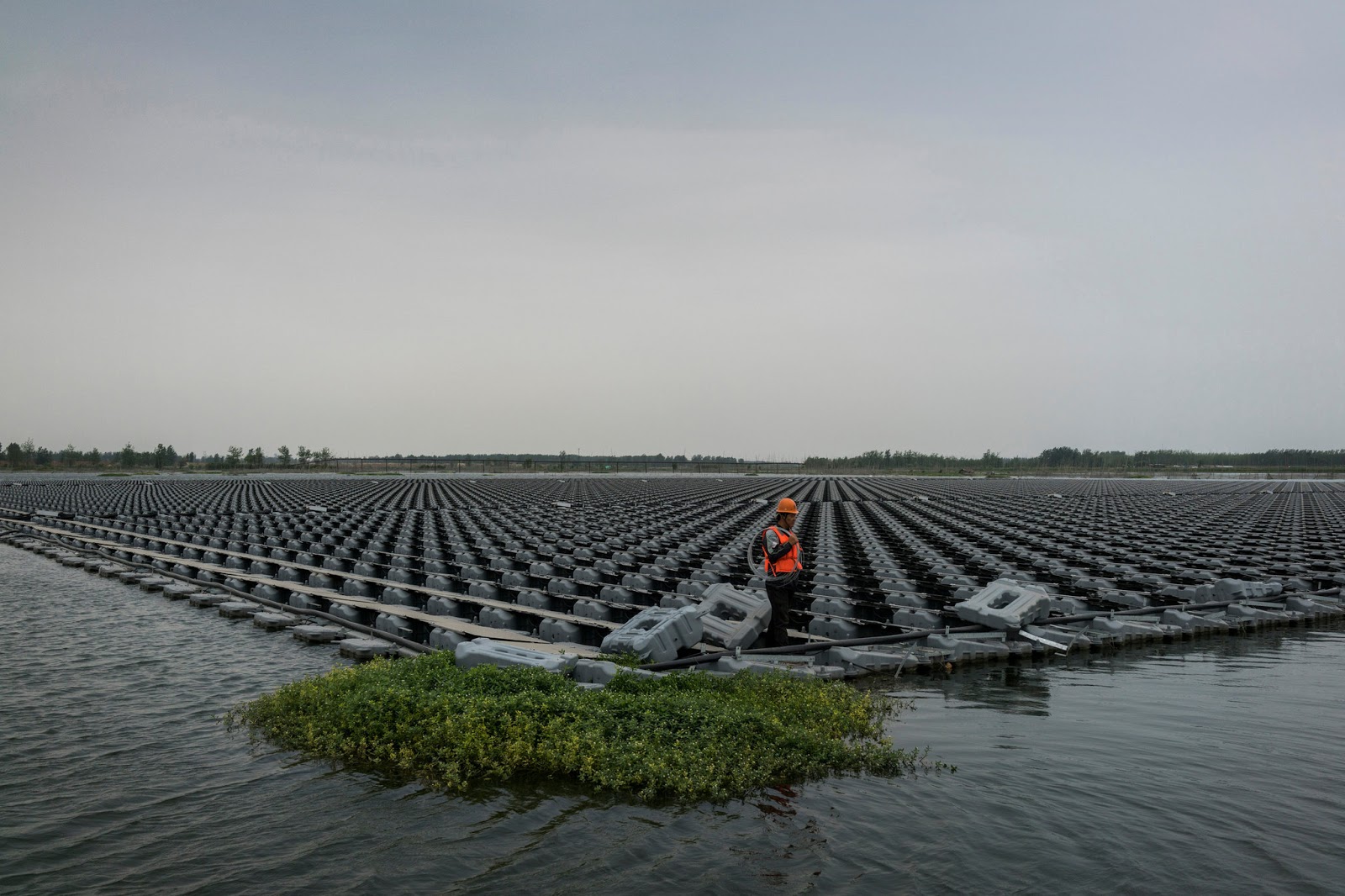Today, the Conservatives are questioning the establishment of “Canada Infrastructure Bank”. Whereby the Conservatives charge that “the Liberal government is asking taxpayers for $35 billion—which roughly equals $1,000 per Canadian—to start a new “infrastructure bank.”
Obviously, our focus is folks-orientated as usual: So, how does the proposed “Canada Infrastructure Bank” benefit folks with “higher tax of $1,000 per Canadian”?
- Does it increase value of real estate?
- Does it make housing more affordable?
On a related note,
- Does it bring more jobs?
- Does it elevate income of Canadians?
or perhaps,
- Does it make our planet greener?
- Does it create any other benefits to folks that we cannot phantom at the moment?
Green Infrastructure?

Solar panels floating on a lake created by the collapse of abandoned coal mines, Liulong, China
Trust the Liberals will provide satisfactory answers to the questions (and beyond).
According the Liberals,
Canada Infrastructure Bank – Liberal Party of Canada
We will establish the Canadian Infrastructure Bank to provide low-cost financing for new infrastructure projects.
The federal government can use its strong credit rating and lending authority to make it easier and more affordable for municipalities to build the projects their communities need.
Where a lack of capital represents a barrier to projects, the Canada Infrastructure Bank will provide loan guarantees and small capital contributions to provinces and municipalities to ensure that the projects are built.
According to the Conservatives,
What is Canada’s infrastructure bank for?
If your banker asked for $1,000, you would probably reply: “what for?”
The Liberal government is asking taxpayers for $35 billion—which roughly equals $1,000 per Canadian—to start a new “infrastructure bank.”
So it’s fair for us to ask: “what for?” Let us go through the possible reasons until we find the real one.
The most obvious reason is to fund infrastructure. But there is nothing preventing private sector banks, capital markets, pension funds, and private equity enterprises from investing in infrastructure. In fact, they already bankroll trillions of dollars of construction projects—to the tune of $2 trillion worldwide, according to estimates in the government’s Fall Economic Update. With so much private money, the last thing we should need is a government bank to provide more. So that can’t be the reason.
Perhaps we need the new bank to bridge those private dollars into public projects, like mass transit? Yet, here again, the government’s Fall Economic Statement boasts that such investments are already happening. It cited the $2 billion Canada Line that moves over 120,000 passengers daily between Vancouver’s downtown, suburbs, and airport, with investment from SNC-Lavalin and Quebec’s Caisse de dépôt pension plan. Quebec pensioners helped build mass transit for British Columbians, whose transit fares help fund Quebec pensions.
But just as with the privatizations of the 407 toll highway in Toronto and the Canadian National Railway, there was no need for a government bank to attract private infrastructure dollars.
So what is the bank for?
The answer appears to have been given by the Canadian Electricity Association, in its submission to the House of Commons transport committee on how the bank should work: “Also important is the inclusion of derisking mechanisms such as loan guarantees….” Bingo.
In one sentence, the power companies explained the real purpose of this bank: taxpayer-funded guarantees that protect investors from losses. Indeed, the government bill that creates the infrastructure bank uses the term “loan guarantee” 14 times. So the power companies are onto something.
via Trillium Times, Conservative Party of Canada
Meanwhile, let’s take a look what interesting properties are up for sales: –
FOR SALES
73 Astley Avenue – ROSEDALE
Asking Price $2,650,000
4+1 bedroom, 4 bathroom house with 2 parking spots on a 33 x 222 foot ravine lot at 73 Astley Avenue in Rosedale.
In 2015, it was listed at $1,759,000. I’m not sure what it sold for.
It is now listed at $2,650,000.
___________________
For Sales
10 Highland Avenue – ROSEDALE
Asking Price: $22,000,000
Notes: PRICE DROP ($27,500,000 one year ago)
6 bedroom, 11 bathroom, 17,000 square foot house with 16 parking spots on an almost 1 acre of land at 10 Highland Avenue.
Everything is grand and DONE … Fit for the Queen.
One year ago when the asking price was $27,500,000. It never sold and it has now had a price drop. The new asking price is $22,000,000.
______________________________
For Sales
508 Delaware Avenue – DUFFERIN-DAVENPORT
Asking Price: $1,599,000
3 bedroom, 2 bathroom house on a 18 x 123 lot with a 3 car garage that ticked a lot of boxes of the then current design trends such as the bike on the wall, the lights, the industrial chairs, the antlers.
It was listed at $749,000 when it was last listed at the end of 2012. It sold for asking.
It is now back on the market with some good updates. The asking price is $1,599,000.
__________________________
For Sales
202 Howard Park Avenue – RONCESVALLES/HIGH PARK
Asking Price: $1,895,000
5 bedroom, 1 bathroom house on a 35 x 240 foot lot at 202 Howard Park Avenue in Roncesvalles/High Park.
It sold at the beginning of April for $1,009,000 with an asking price of $949,000.
The new asking price for this house is $1,895,000.
______________________________________
For Sales
17 Frank Crescent – WYCHWOOD/HILLCREST
Asking Price: $3,150,000
5 bedroom, 5 bathroom house with a detached garage on a 45 x 108 foot lot at 17 Frank Crescent in Wychwood/Hillcrest.
The new asking price is $3,150,000.
________________________________
For Sales
140 First Avenue – RIVERSIDE
Asking Price: $1,049,000
3+1 bedroom, 1 bathroom house with 1 parking spot on a 15 x 123.67 foot lot at 140 First Avenue.
The asking price is $1,049,000.
Sounds like a deal.
_______________________
Looks like there is no clear trend in term of market price yet.
Need financing options? Check out the Canada Infrastructure Bank – see if you can classify properties listed above as some kind of ‘Infrastructure”?





